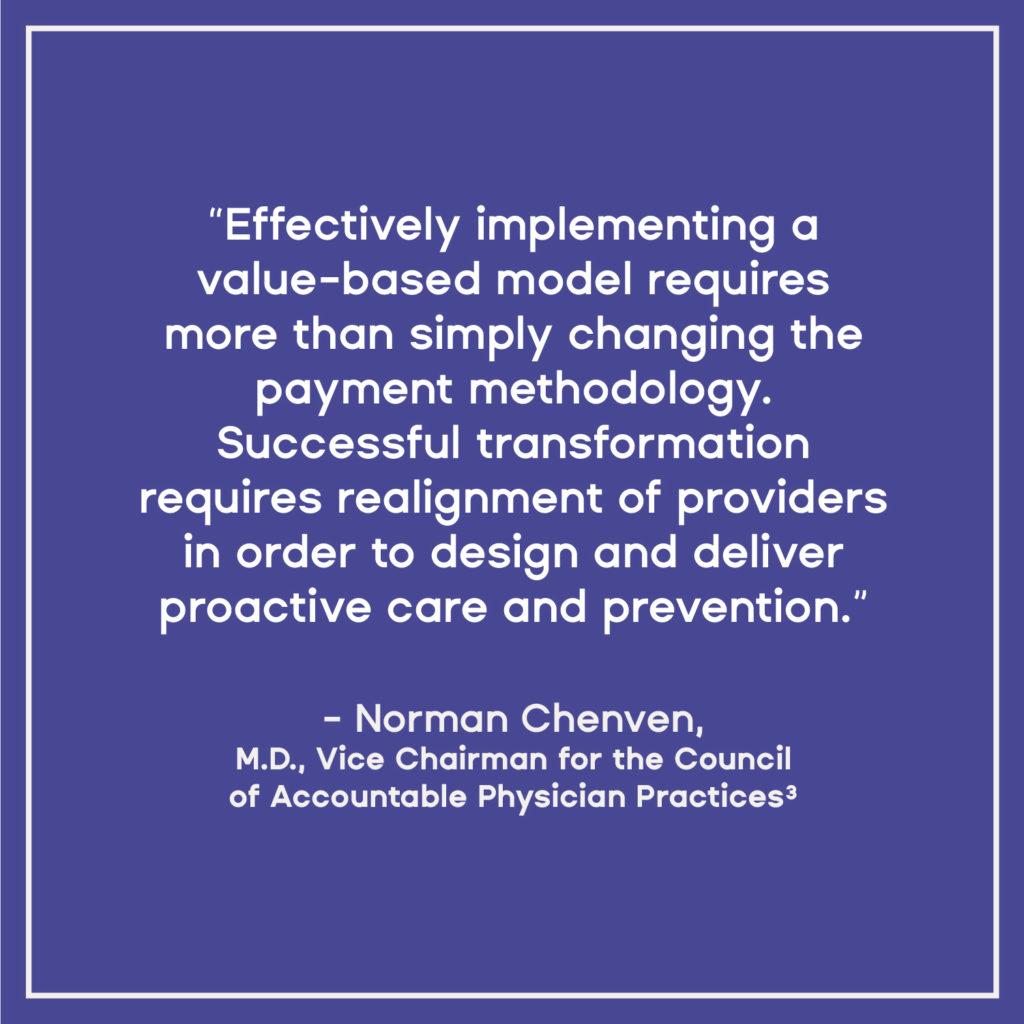Throughout the history of U.S. healthcare, the predominant mechanism for financial compensation has been fee-for-service: hospitals, doctors and providers have been compensated based on the number of patient visits, procedures, or other services rendered. This volume-based approach has not only driven up costs of healthcare in the U.S, it has also resulted in poor distribution of resources and led to less-than-optimal patient outcomes. The system must embrace a better approach. Rather than incentivizing volume, value-based care targets overall quality and results.
In recent years, the Center for Medicare and Medicaid Services (CMS) has introduced a number of value-based care programs. These programs aim to shift the way providers are incentivized to deliver healthcare service. Such a transition will not be easy, especially given the longstanding, entrenched nature of our fee-for-service system. But a value-based model of healthcare invites new, exciting opportunities to improve U.S. healthcare while creating much-needed efficiencies. If providers and payers can see past the initial difficulties embedded in this necessary transition, we can more fully realize the potential these models offer.
Understanding Value-Based Care
In order to understand the basic premise of value-based care, it’s important to appreciate the definition of value. In this context, value is defined as using the least amount of resources consistent with achieving quality outcomes. Unfortunately, our existing fee-for-service models have failed in this regard: because reimbursements are given for incremental units of care, like patient visits and procedures, the system is incentivized to deliver more (and more costly) care, not solve a given patient’s problem; and costs have skyrocketed as a result.
In value-based care models, the optimized unit is not a test, procedure or patient encounter. Instead, revenue is structured around providing the care needed to promote optimal health results, rewarding providers who manage patients’ health most efficiently. Providers must consider all visits, procedures, and interventions and their impact on the patient’s wellbeing. They must also determine how to better allocate time and other resources to achieve quality outcomes across their patient panel. A value-based model of healthcare recognizes the value of preventive care and care coordination, and incentivizes providers through reimbursements that are structured to make wiser decisions and ensure a patient’s needs are met: when a patient is not well-managed, otherwise unnecessary acute interventions are generally required, causing the cost of that patient’s care to go up, which reduces the revenue of the providers responsible for delivering quality care.
Key Features of Value-Based Care
In fee-for-service healthcare models, there is a tendency for providers to work in silos: a hospitalist manages the patient while in the hospital, another provider likely delivers care after discharge, and still others might address special needs requiring specific expertise, all with minimal coordination between these providers. Because each provider is reimbursed for the units of care delivered, there is no incentive for coordination of care. But a value-based model of healthcare focuses on the overall health outcomes of the patient, making collaboration essential to efficient resolution or management of conditions.
Due to this reimbursement model, value-based care necessitates a team-based approach: the entire care team has an incentive to create the best outcome at the lowest cost. It also encourages providers to consider stepwise approaches to care and a holistic approach to health. For example, a mindfulness therapist may offer greater value (better results at lower cost) than the more transactional, quicker ‘resolution’ of prescribing prescription medication. These models inherently encourage a shift from reactive medicine to proactive, preventive approaches, investing in the long term health of patients.
Challenges of Value-Based Healthcare
There are many challenges facing providers hoping to embrace a value-based model of healthcare. One such challenge is working within the bounds of the benefits a payer may cover. For example, if mindfulness therapy is not a covered treatment, then patients may not be able to follow a provider’s recommended care plan without undue financial burden. Even if it represents the most efficient opportunity for addressing a given patient’s situation, it may become impractical to elect this path. Achieving real value will require all stakeholders to participate to realize desired results, trusting in broader incentive alignment rather than tightly defined rigid rules, and giving providers the freedom to work within these bounds.
These challenges do not imply that a value-based model of healthcare is not realizable, and overcoming the pains of this transition is essential. A value-based care approach incentivizes the systems responsible for patient care to invest in tools and analytics that will guide providers to more effective care and ensure adequate coordination. It incentivizes providers and payers to overcome present challenges through creative and innovative thinking. This will be the mindset required in order for us to slow and reverse the ever-increasing costs the healthcare system has represented over the last fifty years.
1 Joszt, L. (2021). CMMI Remains Dedicated to Value-Based Care Despite Pause to Some Models, Fowler Says. AJMC. Retrieved from https://www.ajmc.com/view/cmmi-remains-dedicated-to-value-based-care-despite-pause-to-some-models-fowler-says
2 LaPointe, J. (2021). HHS Secretary Alex Azar Resigns, Effective Jan. 20. RecycleIntelligence.com. Retrieved from https://revcycleintelligence.com/news/hhs-secretary-alex-azar-resigns-effective-jan.-20
3 Medical Economics Staff. (2021). Top Challenges 2021: #8 Transitioning to value-based care models. Medical Economics. Retrieved from https://www.medicaleconomics.com/view/top-challenges-2021-8-transitioning-to-value-based-care-models





